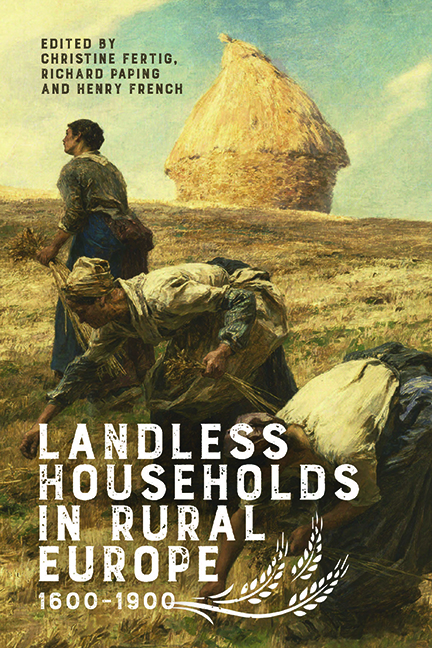15 results
Preface
-
-
- Book:
- Landless Households in Rural Europe, 1600-1900
- Published by:
- Boydell & Brewer
- Published online:
- 08 October 2022
- Print publication:
- 19 July 2022, pp xv-xvi
-
- Chapter
- Export citation
Notes on Contributors
-
- Book:
- Landless Households in Rural Europe, 1600-1900
- Published by:
- Boydell & Brewer
- Published online:
- 08 October 2022
- Print publication:
- 19 July 2022, pp xii-xiv
-
- Chapter
- Export citation
Contents
-
- Book:
- Landless Households in Rural Europe, 1600-1900
- Published by:
- Boydell & Brewer
- Published online:
- 08 October 2022
- Print publication:
- 19 July 2022, pp v-vi
-
- Chapter
- Export citation
3 - The Rise of Landless Households in the Dutch Countryside, c. 1600–1900
-
-
- Book:
- Landless Households in Rural Europe, 1600-1900
- Published by:
- Boydell & Brewer
- Published online:
- 08 October 2022
- Print publication:
- 19 July 2022, pp 63-90
-
- Chapter
- Export citation
Index
-
- Book:
- Landless Households in Rural Europe, 1600-1900
- Published by:
- Boydell & Brewer
- Published online:
- 08 October 2022
- Print publication:
- 19 July 2022, pp 319-330
-
- Chapter
- Export citation
Boydell Studies in Rural History
-
- Book:
- Landless Households in Rural Europe, 1600-1900
- Published by:
- Boydell & Brewer
- Published online:
- 08 October 2022
- Print publication:
- 19 July 2022, pp 331-331
-
- Chapter
- Export citation

Landless Households in Rural Europe, 1600-1900
-
- Published by:
- Boydell & Brewer
- Published online:
- 08 October 2022
- Print publication:
- 19 July 2022
List of Illustrations
-
- Book:
- Landless Households in Rural Europe, 1600-1900
- Published by:
- Boydell & Brewer
- Published online:
- 08 October 2022
- Print publication:
- 19 July 2022, pp vii-xi
-
- Chapter
- Export citation
Bibliography
-
- Book:
- Landless Households in Rural Europe, 1600-1900
- Published by:
- Boydell & Brewer
- Published online:
- 08 October 2022
- Print publication:
- 19 July 2022, pp 293-318
-
- Chapter
- Export citation
Frontmatter
-
- Book:
- Landless Households in Rural Europe, 1600-1900
- Published by:
- Boydell & Brewer
- Published online:
- 08 October 2022
- Print publication:
- 19 July 2022, pp i-iv
-
- Chapter
- Export citation
Introduction
-
-
- Book:
- Landless Households in Rural Europe, 1600-1900
- Published by:
- Boydell & Brewer
- Published online:
- 08 October 2022
- Print publication:
- 19 July 2022, pp 1-11
-
- Chapter
- Export citation
11 - Dutch Live-In Farm Servants in the Long Nineteenth Century: The Decline of the Life-Cycle Service System for the Rural Lower Class
-
-
- Book:
- Servants in Rural Europe
- Published by:
- Boydell & Brewer
- Published online:
- 18 April 2018
- Print publication:
- 30 November 2017, pp 203-226
-
- Chapter
- Export citation
Contributor affiliations
-
-
- Book:
- Textbook of Neural Repair and Rehabilitation
- Published online:
- 05 May 2014
- Print publication:
- 24 April 2014, pp ix-xvi
-
- Chapter
- Export citation
Contributor affiliations
-
-
- Book:
- Textbook of Neural Repair and Rehabilitation
- Published online:
- 05 June 2014
- Print publication:
- 24 April 2014, pp ix-xvi
-
- Chapter
- Export citation
The Nobility of Holland: From Knights to Regents, 1500–1650. By H. F. K. van Nierop. Cambridge: Cambridge University Press, 1993. Pp. xvii, 252. (No price given.)
-
- Journal:
- The Journal of Economic History / Volume 54 / Issue 3 / September 1994
- Published online by Cambridge University Press:
- 03 March 2009, pp. 695-696
- Print publication:
- September 1994
-
- Article
- Export citation

